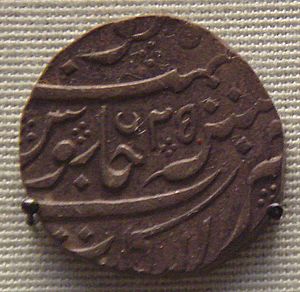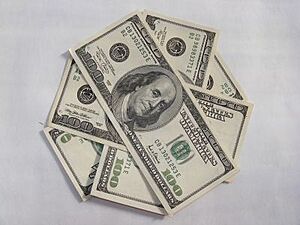History of money facts for kids
The history of money is all about how we've traded things over time. Instead of just swapping items directly (like trading a toy for a book), money helps us trade indirectly. It's a special tool that makes buying and selling much easier!
Money can be physical, like coins and banknotes. Or it can be digital, like numbers in a bank account or on your phone.
Contents
How Money Started
Money was invented a very, very long time ago, even before people started writing down history!
In ancient times, people used many different things to trade. This included animals like cows, grains, shiny cowrie shells, or beads. These were often swapped for other useful items. This kind of direct swapping is called bartering.
It's hard to know exactly when money truly began. But we know it appeared in two main ways:
- Money of account: This was like keeping records of who owed what, often written on ledgers.
- Money of exchange: These were physical items used for trading, like clay tokens, leather, paper, or metal.
In old empires like Egypt, Babylon, India, and China, big temples and palaces stored goods. They used clay tokens or other items to show who owned a part of these stored goods. But these tokens were mostly for keeping records, not for trading in markets.
Metals, both common ones and precious ones like gold and silver, also became a form of money. For example, the Romans first used "rough bronze" (called aes rude). Later, they used "heavy bronze" (called aes grave or As). This was an early step towards using metal coins.
The Story of Coins
Gold and silver have been the most popular types of money for most of history. In many languages, the word for silver is still very similar to the word for money! Sometimes other metals were used too. For instance, ancient Sparta made coins from iron. They did this to stop their citizens from trading too much with other countries.
In the 1600s, Sweden didn't have much gold or silver. So, they made "plate money." These were huge copper slabs, sometimes 50 cm wide, with their value stamped on them!
Gold coins started being made again in Europe in the 1200s. People say Frederick II brought them back during the Crusades. By the 1300s, Europe switched from silver coins to gold coins. Vienna, for example, made this change in 1328.
Metal coins were great because their value was right there in the metal itself. But this also caused problems. People would sometimes shave off small bits of the precious metal from the edges of coins, a trick called "clipping."
Another challenge was having gold, silver, and copper coins all used at the same time. For example, in England in the late 1600s, the value of a gold guinea coin started to rise compared to the silver crown. Things became more stable when national banks promised to exchange silver money for gold at a set price.
Over time, coins also changed from being a unit of weight (like a certain weight of gold) to being a unit of value (like "one dollar").
The First Paper Money
Paper money first appeared in China during the Song Dynasty in the 11th century. The idea of banknotes actually began even earlier, in the seventh century. By the early 1100s, China was printing a huge amount of banknotes every year.


In the 13th century, European travelers like Marco Polo and William of Rubruck learned about paper money. Marco Polo wrote about paper money in China's Yuan Dynasty in his famous book, The Travels of Marco Polo. He even had a chapter called "How the Great Kaan Causeth the Bark of Trees, Made into Something Like Paper, to Pass for Money All Over his Country."
Europe's First Banknotes

The very first European banknotes were printed in 1661 by Stockholms Banco in Sweden. This bank was a early version of Sweden's central bank, Sveriges Riksbank. These paper notes replaced the large copper plates that people were using as money.
Banks started printing their own paper notes, which we now call "banknotes." These notes circulated just like government money does today. In England, this happened until 1694. Scottish banks continued to print their own notes until 1850, and they still do today, backed by notes from the Bank of England.
In the United States, many different commercial banks printed their own banknotes throughout the 1800s. At one point, there were over 5,000 different types! Only notes from the biggest, most trusted banks were widely accepted. Notes from smaller banks were often only used locally or accepted at a lower value.
These early banknotes were a type of "representative money." This meant you could take them to the bank and exchange them for gold or silver.
In India, the first paper money was issued by banks like the Bank of Hindostan (1770–1832).
Over time, governments took over the job of printing banknotes. The Bank of England was given the only right to print banknotes in England after 1694. In the United States, the Federal Reserve Bank got similar rights after it was created in 1913. For a long time, these government-issued currencies were still backed by gold or silver. You could theoretically exchange them for the precious metal.
But in 1971, US President Richard Nixon announced that the US dollar would no longer be directly exchanged for gold. Since then, the US dollar, and most other national currencies, are "free-floating." This means their value changes based on the economy, not on how much gold a country has.
Payment Cards
In the late 1900s, payment cards became super popular. These included credit cards and debit cards. They became the main way people paid for things in many developed countries.
The Bankamericard, launched in 1958, was the first credit card to be widely used and accepted across the United States. Soon after, Mastercard and American Express followed.
Outside of America, other payment cards became popular, like France's Carte Bleue.
Digital Money
As computers became more advanced in the late 20th century, money could be stored as digital information. By 1990, in the United States, almost all money moved between the central bank and other banks was electronic. By the 2000s, most money existed as digital currency in bank computer systems. In 2012, depending on the country, between 20% and 58% of all payments were electronic. Digital money makes payments easier, faster, and more flexible.
Cryptocurrencies
Cryptocurrency In 2008, someone (or a group) called Satoshi Nakamoto created Bitcoin. It was launched that same year. Bitcoin uses special computer code called cryptography. This allows it to have a secure, unique, and tamper-proof record of all transactions. This record is called a blockchain.
Bitcoin became the first widely used decentralized (meaning no single boss) and peer-to-peer (meaning people send money directly to each other) cryptocurrency. Other similar systems had been thought of since the 1980s. But Nakamoto's system solved a big problem called the "double-spending" problem. This means you can't spend the same digital money twice, without needing a trusted third party like a bank.
Since Bitcoin started, thousands of other cryptocurrencies have been created.
Images for kids
-
Spade money from the Zhou Dynasty in China, around 650–400 BC.
See also
 In Spanish: Historia del dinero para niños
In Spanish: Historia del dinero para niños





